Fall is a season of transformation. Across the US, landscapes glow with brilliant autumn colors, creating scenes that are as fleeting as they are magical.
If you’ve recently moved to the US, your first autumn can feel especially memorable. Whether you’re looking for the best places to see fall colors or just want to enjoy the crisp air on a quiet trail, knowing the best fall foliage spots and when to visit can make the season more rewarding.
From classic destinations like New England to hidden gems in the Midwest and South, each region offers its own way to experience the season. In this Remitly guide, we’ll share what we think are some of the most beautiful places to visit in the US, along with practical tips to help you plan your trip and make the most of the season.
Why fall foliage is so spectacular
The beauty of fall is one of the glories of nature, and it’s all down to the science of leaf senescence—aging, in other words. During spring and summer, leaves stay green because of chlorophyll, the pigment that helps plants turn sunlight into energy. As days shorten and temperatures cool, chlorophyll breaks down, revealing the reds, oranges, and yellows that were already present in the leaves.
A few factors influence how vivid the colors appear:
- Temperature
Warm, sunny days followed by cool, but not freezing, nights often bring out the brightest reds. - Sunlight
Ample sunlight helps pigments develop fully. - Moisture
Healthy rainfall during the year keeps trees strong for longer, but too much or too little can soften the colors.
Different tree species also add their own unique hues to the landscape. Maples turn brilliant red, oaks deepen to brown or russet, birches glow bright yellow, and aspens shimmer with gold. And of course some trees, like pines, don’t lose their leaves, keeping some green in the mix too.
Because the season unfolds gradually, peak foliage starts earlier in the north and at higher elevations, then spreads southward and into valleys. This gives you a window of several weeks to experience the autumn colors, and if you’re a recent arrival to the US, this means you don’t just get plunged into winter with no warning.
So let’s have a look at some of the places we think are the most spectacular.
New England’s top fall foliage spots
New England is one of the nation’s most popular autumn destinations to experience the season’s changing colors. From winding roads to forest trails, the area’s spectacular scenery makes it a favorite destination for many fall travelers.
Vermont’s Green Mountain National Forest
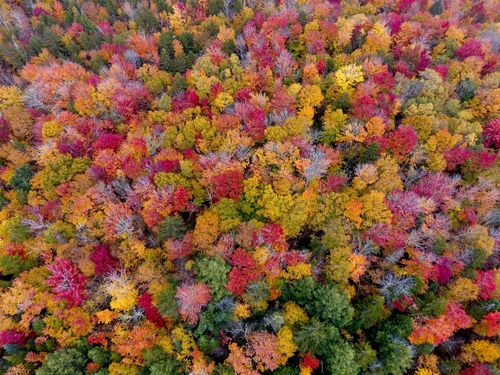
The Green Mountain National Forest in southwestern and central Vermont has year-round appeal, but it shines most brightly in autumn when the mountains are lit up with color. The forest is known for its autumn sugar maples, which glow in shades of red, orange, and gold in the fall.
A scenic drive along Route 100 takes you through rolling hills and small towns, while hiking trails bring you closer to the foliage. For a more immersive experience, activities like mountain biking, camping, fishing or hunting are also available. Peak color usually falls between late September and early October, though the exact timing varies depending on the year.
New Hampshire’s White Mountain National Forest
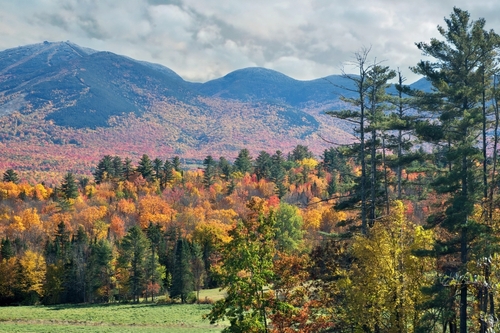
The White Mountains in New Hampshire offer both relaxing drives and active hikes to get the heart pumping. The Kancamagus Highway is a 34-mile route through forests, rivers, and mountains, with overlooks that are easy to stop at along the way.
For more of an adventure, hiking trails like Arethusa Falls or the Lafayette Loop provide sweeping views from above the colorful canopy. Because parking fills quickly in peak season, early mornings or weekday visits often make for a calmer trip.
Massachusetts’ Berkshire Mountains
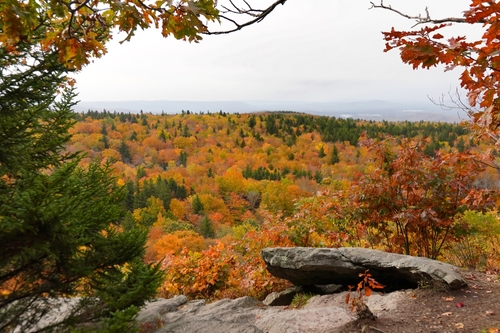
The Berkshires combine forested hills with charming towns and scenic byways. The mix of hardwoods, including maples, birches, and oaks, that create a varied autumn palette. Mount Greylock, the state’s highest point, offers panoramic views, while the Mohawk Trail winds through quiet valleys and historic towns.
You might just be driving through, taking a “pit stop” at a cafe, or hiking all day—the Berkshires offer you plenty of ways to enjoy the colors at your own pace.
Hidden gems in the mid-Atlantic
If you’d like to enjoy autumn colors in quieter settings, the mid-Atlantic offers beautiful scenery without the heavy crowds of New England.
Pennsylvania’s Pocono Mountains
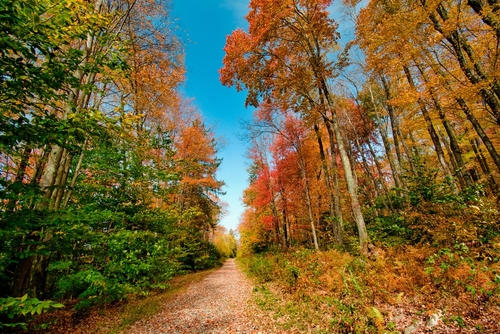
The Pocono Mountains combine forested hills, waterfalls, and lakes that come alive with autumn colors. State parks like Bushkill Falls and Promised Land have overlooks and short trails that are easy to explore, even if you’re only there for a short visit.
You can also combine leaf viewing with seasonal activities like apple picking, corn mazes, or a cozy cabin stay. If you prefer things quiet, consider visiting during the week rather than on weekends.
New York’s Adirondack Park
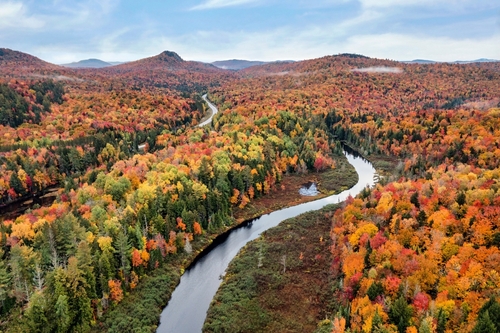
Adirondack Park is one of the largest protected areas in the US, with forests, lakes, and mountains that make fall especially scenic.
Well-known leaf peeping locations, like Lake Placid and Cascade Mountain Trail, are popular for casual viewing and day hikes. If you’d like a quieter experience, smaller trailheads or a canoe trip on one of the lakes offer a peaceful way to see the autumn colors close up.
Southern fall foliage spots
In the South, fall colors arrive gradually, which often means a longer viewing season. This can be a great option if you’re hoping to plan a trip later in the autumn or you’re lucky enough to be able to spread out your visits across several weeks.
North Carolina’s Blue Ridge Parkway
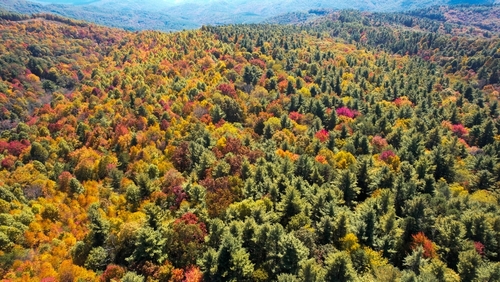
The Blue Ridge Parkway is known for its scenic curves and changing elevations, which extend the foliage viewing season from early October into November.
Popular overlooks like Humpback Rocks (mile 5.8) and Craggy Gardens (mile 364.4) are easy spots to pause and take in the view over a short walk or picnic lunch. The mix of hardwoods and evergreens creates layers of color that shift as you move through the park.
Tennessee’s Great Smoky Mountains
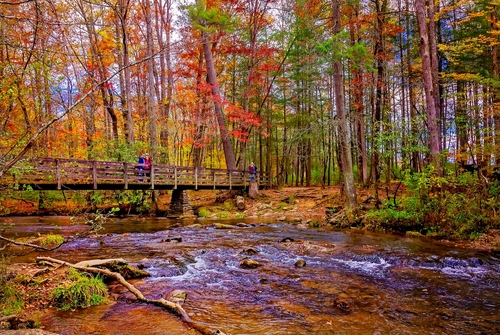
The Great Smoky Mountains are home to over 100 native tree species, making the fall color palette especially varied.
Accessible trails such as Clingmans Dome and Newfound Gap Road provide wide views over the canopy. Entry to the park is free, but parking can get crowded on weekends, so just as with other popular spots, if you’re able to get there early in the morning or on weekdays your visit will likely be a calmer experience.
Best fall foliage spots in the midwest
Autumn in the Midwest brings together forested hills, lakeshores, and peninsulas. The scenery changes with the light and weather, giving visitors something new to see each day.
Michigan’s Upper Peninsula
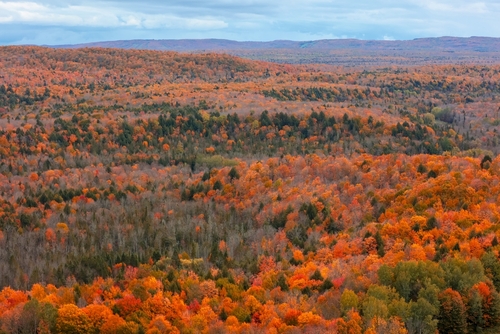
Michigan’s Upper Peninsula, often recognized as one of the top fall color viewing areas in the US, is known for its mix of lakefront views and wide stretches of forest that turn vibrant in autumn. Scenic drives like M-123 near Tahquamenon Falls or Pictured Rocks National Lakeshore highlight cliffs, waterfalls, and colorful reflections on the water.
Because the Great Lakes affect the local climate, peak foliage can arrive later than in inland areas—usually from mid-September to mid-October. Towns are spread out, and cell service can be limited, so it helps to come prepared with waterproof gear, snacks, water, and even a paper map. Old-fashioned but unaffected by a lack of signal!
Wisconsin’s Door County
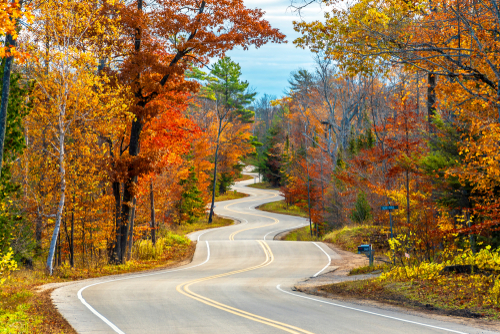
Door County is a peninsula of small towns, rolling orchards, and shoreline forests. Scenic drives and trails pass lighthouses, vineyards, and parks, so it’s easy to combine leaf peeping with a top at a café or local winery.
The surrounding water reflects both the sky and trees, adding to the calm and colorful atmosphere of the season.
Best fall color viewing areas in the west
In the western US, fall shows up in mountain valleys, canyons, and high elevations, offering a different kind of seasonal scenery than in the rest of the country.
Colorado’s aspen groves
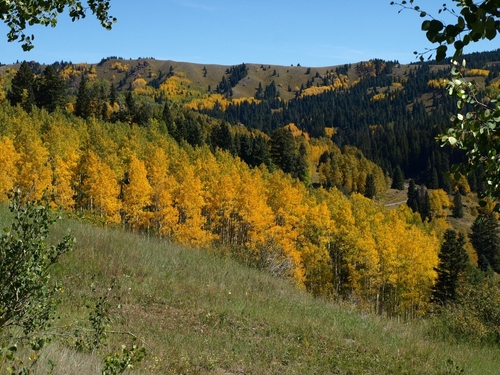
Colorado is known for its aspen groves, which turn a bright golden shade in the fall. Roads like Kebler Pass, Independence Pass and areas near Maroon Bells make it easy to see these groves up close.
Because elevation changes the timing of peak colors, higher areas often turn earlier in the season. If you plan your trip with this in mind, you’ll have a better chance of catching the aspens at their brightest.
Utah’s Wasatch Mountains
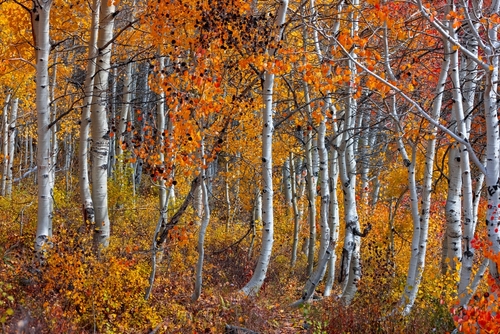
The Wasatch Mountains near Salt Lake City combine golden aspens with striking red rock formations. Big Cottonwood Canyon and Mill Creek Canyon are popular fall foliage spots for short hikes and scenic drives because they’re easy to reach from the city.
Colors often peak in early October, and higher viewpoints provide wide views of warm, autumnal tones against rugged, arid cliffs.
Planning your fall foliage adventure
Fall colors don’t last long, and a little planning goes a long way to make your trip to these destinations both enjoyable and stress-free.
Timing your visit
The timing for seeing these colors at their peak depends on latitude, elevation, and local climate. Many travelers plan multiple fall road trips if they can, visiting different regions to catch the best displays.
In general, northern regions and higher elevations peak from late September to mid-October, while southern areas and lower elevations peak from mid-October into early November.
To check local timing, you can use foliage prediction websites and apps that track leaf color changes in real time, such as:
Since weather can be unpredictable, it’s helpful to have backup options, such as nearby drives, short hikes, or even the more attractive towns with tree-lined streets. And keep in mind what we’ve said about all these places—the weekends are likely to be much busier than weekdays at all of them.
What to bring
Autumn can be chilly, windy, rainy, or all three at the same time. Packing layers and a few essentials will help you stay comfortable in all weathers.
- Clothing: layers! A waterproof jacket, comfortable shoes, gloves, and a hat.
- Photography gear: camera or phone, tripod, extra batteries, and a water-resistant bag.
- Snacks and essentials: water, portable snacks, small first-aid kit, sunglasses, sunscreen—even if it’s chilly, when the sun’s out you’re still vulnerable to sunburn.
Driving and safety: navigation app, paper map, and a roadside kit if you’re driving in rural areas.
Photography tips
You don’t need advanced equipment to take good fall photos. Paying attention to light and framing can make a big difference:
- Lighting
Early mornings and late afternoons—the golden hour—provide soft, warm light that enhances color, while overcast days soften harsh shadows and make hues pop. - Composition
Reflective water, winding roads, or including people for scale can add depth and interest to your photos. And sometimes, putting the people or mountain you’re snapping right in the middle of the frame doesn’t give you the best shot. Remember photography’s rule of thirds. - Smartphone tips
HDR mode helps with color depth, and taking multiple shots from different angles gives you more options.
Making the most of your trip
Fall foliage trips are also a chance to enjoy local traditions like apple picking, harvest festivals, or farmers’ markets. Many towns in foliage regions have cozy cafés, vineyards, or historic sites that we think are well worth exploring.
Since accommodations often fill up quickly, booking early can help reduce the stress of finding the right accommodation. Supporting local businesses—by shopping local, eating at family-run cafés, or visiting public parks—also helps the communities you visit thrive.
Always respect nature, keeping your distance from wild animals and sticking to the guidelines and rules in parks and reserves. It’s easy to forget just how huge and remote some of these wilderness areas are, and how easy to get lost if you’re not properly prepared or following the trails.
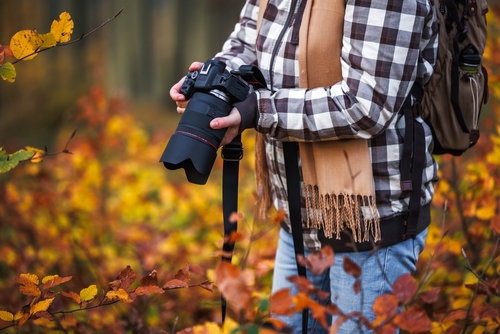
What Are the Best Fall Foliage Spots in Sweden?
For breathtaking fall foliage, Sweden offers stunning destinations like Abisko National Park and the forests of Dalarna. The vibrant reds and golds create picturesque landscapes, perfect for photographers and nature lovers. While visiting, immerse yourself in the local heritage by exploring sweden’s nature and cultural highlights throughout this beautiful season.
Start planning your fall foliage adventure today
Each of the regions we’ve explored here, from Blue Ridge Parkway’s layered canopy to Colorado’s golden aspens, has something unique to see. But just turning up and hoping for the best might lead to disappointment—peak foliage usually lasts only two to three weeks in any one place, so checking local reports and planning ahead can help you make the most of the season.
Whether you’re hiking along a mountain trail, driving through a forested highway, or enjoying reflections on a quiet lake, autumn offers plenty of moments worth savoring. Enjoy those fall colors.
FAQs
When is the best time to see fall foliage?
Northern states and higher elevations often peak late September to mid-October. Southern states and lower elevations usually peak mid-October to early November. Check foliage apps for local timing.
Where are the most beautiful fall colors?
Colors shine across the country, but some of the best places to see fall colors include New England, the Blue Ridge Parkway, Michigan’s Upper Peninsula, and Colorado’s aspen groves.
How long does peak foliage usually last?
Not that long. Peak color typically lasts two to three weeks, though weather can shorten or extend the season.
Do I need special gear for hiking or driving during foliage season?
Not really special gear, but certainly you need adequate clothing and equipment. Layers, a waterproof jacket, and comfortable walking shoes are must-haves. A camera or smartphone with extra batteries is useful if you want to take photos.
Can I combine foliage viewing with other activities?
Yes, many regions offer seasonal experiences like apple picking, vineyard tours, pumpkin patches, or historic towns to explore. Pairing leaf peeping locations with local attractions can make your trip feel fuller and more memorable, and also help you support local businesses.
How can I avoid crowds at popular fall color viewing areas?
Visit early, on weekdays, or explore less-known trails and parks. Many states and tourism boards publish maps of fall color viewing areas, helping travelers discover both well-known overlooks and peaceful, off-the-beaten-path spots.
Are there tools to track leaf color in real time?
Yes, there are plenty of apps and websites that provide up-to-date reports and peak forecasts. We’ve linked to some in the article above.
How can I support local communities during my visit?
Stay at locally owned lodgings, eat at small, independent cafés, and shop at local stores or markets.